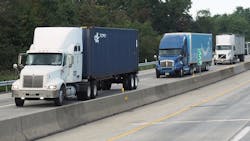Spot market remains ‘hot’ with more freight than capacity
As summer begins and the industry comes out of the recent roadside inspection blitz, industry analysts at FTR report the spot market remains “hot” with a lot more freight than capacity.
“The last week included International Roadcheck, and that’s a time when a lot of truckers decide to take a few days off,” explained Avery Vise, vice president of trucking research at FTR. “We always see a little bit of a blip in the spot market then. Here we are operating at a high level and that blip was pretty substantial.”
Vise noted that the industry remains at full utilization of seated trucks and likely will for most of the rest of the year. He added that there will be a “very modest softening” at the end of the year that will come not from weaker demand, but from higher capacity increases and through current supply chain adjustments to productivity – for instance, better dock scheduling and management.
In order to address those demands, the industry has ramped up its recruiting efforts, and over the past year, the for-hire trucking sector has added 24,000 payroll jobs, Vise said. He also explained that there was a decline in violations when the electronic logging device (ELD) soft enforcement period ended April 1.
“This could be because carriers finally complied with the mandate and activated their ELDs, or it could be that some carriers and drivers just basically decided to call it quits,” Vise explained. “It’s most likely that we saw some of both, but if we saw drivers leave the industry in significant numbers, that could explain the one-month drop we saw in April.”
And given the demand in the market, it’s logical to think that trucking should be adding even more jobs; however, Vise said, two of the biggest labor competitors for trucking are construction and manufacturing. Between them, those sectors have added a number of jobs equivalent to 37% of the entire payroll employment of the trucking industry just in the past year.
“These are two of the most important sectors for freight demand as well, so it’s a bit of a double whammy in the driver shortage arena,” Vise said.
Todd Tranausky, senior transportation analyst at FTR, explained that because of the capacity situation for trucks, railroads should have a real opportunity to take market share and add volumes, but they’re limited by the “unacceptable rail service that they have provided so far for shippers.”
Train speeds in 2018 have been well below what they had been historically over the last decade. Tranausky pointed to a study that said for every one-mile per hour degradation in train speed, shippers need an additional 3% more rail equipment to service the same freight demand.
“We’re at least a mile per hour – in some cases closer to two miles per hour – off what we’ve seen,” he explained. “That’s created additional demand for equipment, especially in a growing economic environment when not only are you trying to move the same volume, but you’re trying to increase volumes to meet demand. Train speeds are certainly not helping, and unfortunately for shippers, probably aren’t going to get better in the near term.”
And given the current capacity situation, freight rates have been on the rise. Vise explained that analysts hope rates will come down a bit in the next week or so, but likely due to the demand in the second quarter, rates will go even higher.
“The actual index values for spot contract show that rates are not going to go down at the end of the year, there will just be a steady and less sharp increase for the rest of the year,” Vise said.
Going forward, Vise pointed out external factors that could affect transportation:
- NAFTA and other trade concerns are bringing uncertainty in the marketplace.
- Asian and European nations are expected to retaliate against recent tariff actions.
- Growth in sand and petrochemical volumes add volume to an already-strained part of the network.
- There is potential for more flexibility around drivers’ hours of service regulations.
About the Author

Cristina Commendatore
Cristina Commendatore is a past FleetOwner editor-in-chief. She wrote for the publication from 2015 to 2023.
